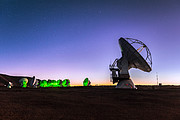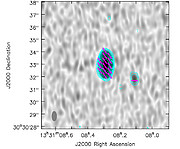Tiedote
ALMA tutkii magneettista Universumia
ALMA:n ensimmäiset täyden polarisaation havainnot todistavat sen kyvykkyydestä polarisaatiohavainnoille
19. heinäkuuta 2016
Äskettäin tehdyt havainnot ovat varmistaneet, että ALMA:n erinomainen herkkyys ja kalibraation tarkkuus tekevät siitä huippulaitteen myös millimetrialueen aallonpituuksien polarimetrisiin havaintoihin.
Vaikka ALMA (the Atacama Large Millimeter/submillimeter Array) on ollut toiminnassa vuodesta 2011 alkaen, sen tekemien havaintojen toimintakykyä yhä kehitetään. ALMA suunniteltiin myös tarkkojen polarisaatiohavaintojen tekemistä varten ja tähtitieteilijät ovat äskettäin julkistaneet ensimmäiset täyden polarisaation mittaustulokset, mitkä varmistavat ALMA:n toimivuuden myös näissä havainnoissa. Radioaaltojen polarisaatio paljastaa erityisesti magneettikentän eri ominaisuuksia.
Tähtitieteilijät havaitsivat kirkasta kohdetta 3C 286. Se on 7.3 miljardin valovuoden etäisyydellä oleva kvasaari, mikä on erittäin voimakas radiosäteilyn lähde. Kohdetta on tutkittu myös useilla muilla teleskoopeilla. Tästä kohteesta tuleva radiosäteily on voimakkasti polarisoitunut, mikä tekee siitä ideaalisen kohteen ALMA:n testaamiseksi tällä tutkimusalueella. ALMA:n havainnot paljastavat ennennäkemättömiä yksityiskohtia ja osoittavat selkeästi, että magneettikenttä on voimakkaampi ja järjestyneempi kvasaarista lähtevän suihkun sisäosiin siirryttäessä. Tämä auttaa tutkijoita ymmärtämään kvasaarin ytimen magneettikentän rakennetta ja tuo esille tärkeitä vihjeitä siitä, mitä fysikaalisia prosesseja radiosäteilyn syntymisessä esiintyy.
“Tämä havainto on todistanut, että ALMA toimii erittäin hyvin polarimetrisissa havainnoissa.”: Ryhmän vetäjä Hiroshi Nagai Japanin kansallisesta tähtitieteen observatoriosta sanoo. “Tämä on ALMA-projektin tärkeä merkkipaalu.”
Magneettikentät ovat tärkeitä monissa kosmisissa olosuhteissa, mutta niiden mittaaminen on hyvin vaikeaa. Polarimetria on yksi harvoista käytettävissä olevista menetelmistä. Radioaaltojen polarisoitunut komponentti voi kuitenkin olla vain muutamia prosentteja kohteesta tulevasta radiovuosta ja siksi tarkat polarimetriset havainnot tarvitsevat havaintolaitteelta suurta herkkyyttä. ALMA:lla on tarvittava herkkyys näiden ratkaisevan tärkeiden polarimetristen havaintojen tekemiseksi, kuten tämä viimeisin tutkimus on osoittanut.
Lisätietoja
Nämä tulokset julkaistiin "Astrophysical Journal"-lehdessä 20.6.2016 artikkelissa nimeltään “ALMA Science Verification Data: Millimeter Continuum Polarimetry of the Bright Radio Quasar 3C 286”, tekijät H. Nagai et al.
Tutkimusryhmä koostuu seuraavista tahoista: H. Nagai (National Astronomical Observatory of Japan, Tokyo, Japani), K. Nakanishi (National Astronomical Observatory of Japan, Tokyo, Japani; The Graduate University for Advanced Studies, Tokyo, Japani; Joint ALMA Observatory, Santiago, Chile), R. Paladino (INAF-Osservatorio di Radioastronomia, Bologna, Italia), C.L.H. Hull (Harvard-Smithsonian Center for Astrophysics, Cambridge, Massachusetts, USA; Jansky Fellow of the National Radio Astronomy Observatory), P. Cortes (Joint ALMA Observatory, Santiago, Chile; National Radio Astronomy Observatory, Charlottesville, Virginia, USA), G. Moellenbrock (National Radio Astronomy Observatory, Socorro, New Mexico, USA), E. Fomalont (Joint ALMA Observatory, Santiago, Chile; National Radio Astronomy Observatory, Charlottesville, Virginia, USA), K. Asada (The Academia Sinica Institute of Astronomy and Astrophysics, Taipei, Taiwan) ja K. Hada (National Astronomical Observatory of Japan, Tokyo, Japani).
Kansainvälinen tähtitieteen tutkimuslaitos Atacama Large Millimetre/submillimetre Array (ALMA) on ESO:n, US National Science Foundationin (NSF) ja Japanin National Institutes of Natural Sciencesin (NINS) kumppanuushanke yhteistyössä Chilen kanssa. ALMA:a rahoittavat Euroopan eteläinen observatorio (ESO) jäsenmaidensa puolesta, NSF yhteistyössä Kanadan kansallisen tutkimusneuvoston (NRC) ja Taiwanin kansallisen tiedeneuvoston (NSC) kanssa sekä Japanin kansalliset luonnontieteelliset instituutit (NINS) yhteistyössä Taiwanin Academia Sinican (AS) ja Korea Astronomy and Space Science Instituten (KASI) kanssa.
ALMA:n rakentamista ja toimintaa ohjaa Euroopan osalta ESO, Pohjois-Amerikan osalta Kansallinen radiotähtitieteen observatorio (NRAO), jota hallinnoi Associated Universities, Inc. (AUI), ja Itä-Aasian osalta Japanin Kansallinen tähtitieteellinen observatorio (NAOJ). Yhteinen ALMA-observatorio (JAO) huolehtii ALMA:n rakentamisen, kokoonpanon ja operaation yhtenäisestä johdosta ja hallinnoinnista.
Yhteystiedot
Hiroshi Nagai
National Astronomical Observatory of Japan
Osawa 2-21-1
Mitaka, Tokyo, Japan
S-posti: hiroshi.nagai@nao.ac.jp
Peter Grimley
ESO Assistant Public Information Officer
Garching bei München, Germany
S-posti: pgrimley@partner.eso.org
Tiedotteesta
| Tunnistus: | ann16050 |
Our use of Cookies
We use cookies that are essential for accessing our websites and using our services. We also use cookies to analyse, measure and improve our websites’ performance, to enable content sharing via social media and to display media content hosted on third-party platforms.
ESO Cookies Policy
The European Organisation for Astronomical Research in the Southern Hemisphere (ESO) is the pre-eminent intergovernmental science and technology organisation in astronomy. It carries out an ambitious programme focused on the design, construction and operation of powerful ground-based observing facilities for astronomy.
This Cookies Policy is intended to provide clarity by outlining the cookies used on the ESO public websites, their functions, the options you have for controlling them, and the ways you can contact us for additional details.
What are cookies?
Cookies are small pieces of data stored on your device by websites you visit. They serve various purposes, such as remembering login credentials and preferences and enhance your browsing experience.
Categories of cookies we use
Essential cookies (always active): These cookies are strictly necessary for the proper functioning of our website. Without these cookies, the website cannot operate correctly, and certain services, such as logging in or accessing secure areas, may not be available; because they are essential for the website’s operation, they cannot be disabled.
Functional Cookies: These cookies enhance your browsing experience by enabling additional features and personalization, such as remembering your preferences and settings. While not strictly necessary for the website to function, they improve usability and convenience; these cookies are only placed if you provide your consent.
Analytics cookies: These cookies collect information about how visitors interact with our website, such as which pages are visited most often and how users navigate the site. This data helps us improve website performance, optimize content, and enhance the user experience; these cookies are only placed if you provide your consent. We use the following analytics cookies.
Matomo Cookies:
This website uses Matomo (formerly Piwik), an open source software which enables the statistical analysis of website visits. Matomo uses cookies (text files) which are saved on your computer and which allow us to analyze how you use our website. The website user information generated by the cookies will only be saved on the servers of our IT Department. We use this information to analyze www.eso.org visits and to prepare reports on website activities. These data will not be disclosed to third parties.
On behalf of ESO, Matomo will use this information for the purpose of evaluating your use of the website, compiling reports on website activity and providing other services relating to website activity and internet usage.
Matomo cookies settings:
Additional Third-party cookies on ESO websites: some of our pages display content from external providers, e.g. YouTube.
Such third-party services are outside of ESO control and may, at any time, change their terms of service, use of cookies, etc.
YouTube: Some videos on the ESO website are embedded from ESO’s official YouTube channel. We have enabled YouTube’s privacy-enhanced mode, meaning that no cookies are set unless the user actively clicks on the video to play it. Additionally, in this mode, YouTube does not store any personally identifiable cookie data for embedded video playbacks. For more details, please refer to YouTube’s embedding videos information page.
Cookies can also be classified based on the following elements.
Regarding the domain, there are:
- First-party cookies, set by the website you are currently visiting. They are stored by the same domain that you are browsing and are used to enhance your experience on that site;
- Third-party cookies, set by a domain other than the one you are currently visiting.
As for their duration, cookies can be:
- Browser-session cookies, which are deleted when the user closes the browser;
- Stored cookies, which stay on the user's device for a predetermined period of time.
How to manage cookies
Cookie settings: You can modify your cookie choices for the ESO webpages at any time by clicking on the link Cookie settings at the bottom of any page.
In your browser: If you wish to delete cookies or instruct your browser to delete or block cookies by default, please visit the help pages of your browser:
Please be aware that if you delete or decline cookies, certain functionalities of our website may be not be available and your browsing experience may be affected.
You can set most browsers to prevent any cookies being placed on your device, but you may then have to manually adjust some preferences every time you visit a site/page. And some services and functionalities may not work properly at all (e.g. profile logging-in, shop check out).
Updates to the ESO Cookies Policy
The ESO Cookies Policy may be subject to future updates, which will be made available on this page.
Additional information
For any queries related to cookies, please contact: pdprATesoDOTorg.
As ESO public webpages are managed by our Department of Communication, your questions will be dealt with the support of the said Department.


